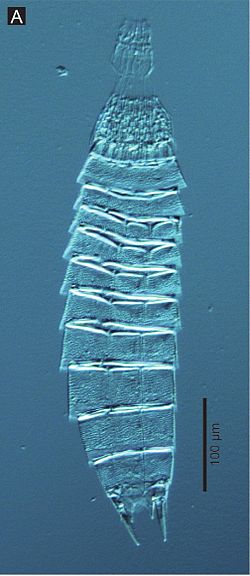Kinorhyncha
Kinorhyncha [1] is a phylum of small (1 mm or less) marine invertebrates. They are widespread in mud or sand at all depths of the sea. They are sometimes called mud dragons. About 222 species are known. Kinorhynchs eat either diatoms or organic material found in the mud, depending on species.
| Kinorhynchs | |
|---|---|

| |
| Scientific classification | |
| Kingdom: | |
| Superphylum: | |
| Phylum: | Kinorhyncha Reinhard, 1887
|
| Orders | |
|
Cyclorhagida | |
Anatomy
Kinorhynchans are segmented, limbless animals. Their body has a head, neck, and a trunk. The trunk has eleven segments. They do not have external cilia, but have a number of spines along the body, and up to seven circles of spines around the head.[2] These spines are used for movement. They can pull back the head and push forward; then they can grip the substrate with the spines, and draw up the body.
The body wall is a thin layer with a tough cuticle. It is moulted several times during growth. This layer is a syncytium, with nuclei, but no cell membranes.
The spines are hollow and covered by cuticle. The head is completely retractable, when is covered by a set of neck plates.[3]
The nervous system is a ventral nerve cord, with one ganglion in each segment, and an anterior nerve ring surrounding the pharynx. This is the common arrangement for invertebrates. Some species have simple ocelli (eye-spots) on the head, and all species have tiny bristles on the body as touch receptors.[3]
Reproduction
There are two sexes that look alike. A pair of gonads are in the mid-region of the trunk, and open to pores in the final segment. In most species, the sperm duct has two or three spiny structures that presumably help in copulation. The larvae are free-living.[3]
Classification
Their closest relatives may be the phyla Loricifera and Priapulida. Together they are the Scalidophora.
Phylum Kinorhyncha
- Order Cyclorhagida
- Order Homalorhagida
Kinorhyncha Media
Living Echinoderes specimen, showing movement and head retraction
Myoanatomy of the body of Echinoderes spinifurca
Echinoderes close up head anatomy
